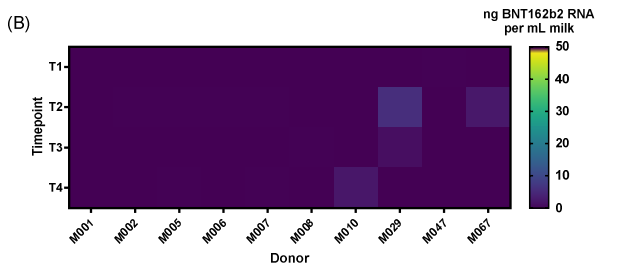
This study looked at the milk of 10 #breastfeeding people who had received an mRNA #COVID19 #vaccine. Key points...
🗝️ Anti-COVID antibodies are present in breastmilk and would be predicted to be protective.
🗝️ Minimal transfer of vaccine mRNA.
More detail below... 🧵
🗝️ Anti-COVID antibodies are present in breastmilk and would be predicted to be protective.
🗝️ Minimal transfer of vaccine mRNA.
More detail below... 🧵
The finding that anti-COVID antibodies make it into breast milk after vaccination is in line with findings from at least six other studies. Too many to post one by one, but you can find links to them here, under question 7.
2/
drive.google.com/file/d/1_wHIYX…
2/
drive.google.com/file/d/1_wHIYX…
The finding that there is "minimal" transfer of vaccine mRNA is worth looking at in a bit more detail. What exactly do they mean by that? 3/
Two previous studies found no detectable transfer of vaccine mRNA. You can find them here... 4/
https://twitter.com/VikiLovesFACS/status/1369004462728228865?s=20
This study uses a technique that concentrates the mRNA from the milk before looking for vaccine mRNA, allowing them to detect much lower levels than the other two papers. 6/
By doing this, can detect very low levels of vaccine mRNA transiently in the milk of 3 of their participants. The most they see is 2ng/mL or 2 parts per 1000,000,000. 7/ 

This is such a low level that on a sensitive assay, it might be contamination. But let's assume the authors have done all their negative controls and it's not. What does 2 parts per 1000,000,000 mean? Enough we should be worried? 8/
I'm going to assume that this audience is familiar with those syringes you use for giving babies Calpol. The whole syringe is 5mL (though if your baby is little, you will only be giving them half a syringe). 9/
Imagine taking that 5mL syringe of Calpol, squirting it into an Olympic (50m) pool, giving it a couple of days to mix and then taking the water/Calpol mixture. You wouldn't expect it to do much, would you?
That's 2 parts per 1000,000,000.
10/
That's 2 parts per 1000,000,000.
10/
We also have to remember that we don't expect the vaccine mRNA to do anything if it's taken in orally. If it did, we would administer it as an oral vaccine, rather than injected people (which almost everyone hates). 11/
So, by using a super-sensitive assay, it is possible to detect very very low levels of vaccine mRNA briefly in the milk of some people. 12/
But the levels are really very very low and I personally would be happy to keep on BF my baby - especially given the potentially protective effect of the antibodies.
Happy to chat, as always! 13/13
Happy to chat, as always! 13/13
Cunningly, I totally failed to attach the paper to the top tweet. 🤦🏻♀️
Here it is...
medrxiv.org/content/10.110…
Here it is...
medrxiv.org/content/10.110…
• • •
Missing some Tweet in this thread? You can try to
force a refresh





